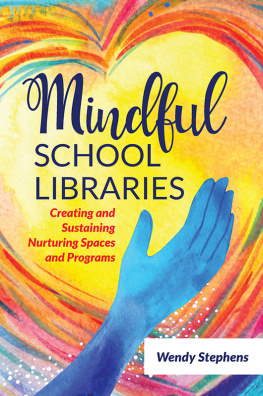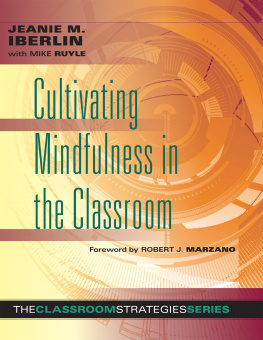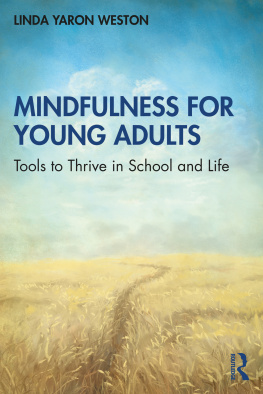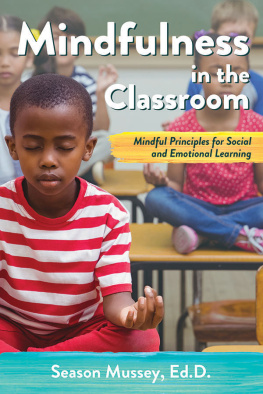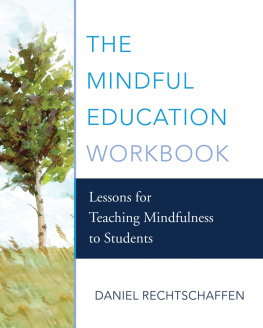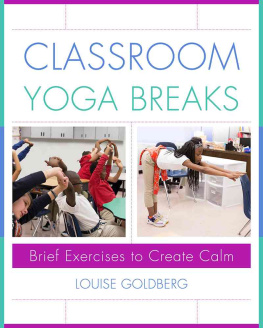Mindful School Libraries
Copyright 2021 by Wendy Stephens
All rights reserved. No part of this publication may be reproduced, stored in a retrieval system, or transmitted, in any form or by any means, electronic, mechanical, photocopying, recording, or otherwise, except for the inclusion of brief quotations in a review, without prior permission in writing from the publisher.
Library of Congress Cataloging-in-Publication Data
Names: Stephens, Wendy, author.
Title: Mindful school libraries : creating and sustaining nurturing spaces and programs / Wendy Stephens.
Description: Santa Barbara, California : Libraries Unlimited, [2021] | Includes bibliographical references and index.
Identifiers: LCCN 2020020563 (print) | LCCN 2020020564 (ebook) | ISBN 9781440875274 (paperback) | ISBN 9781440875281 (ebook)
Subjects: LCSH: School librariesAdministration. | Libraries and teachers. | School librarian participation in curriculum planning. | School librariansProfessional relations. | Affective education.
Classification: LCC Z675.S3 S78 2021 (print) | LCC Z675.S3 (ebook) | DDC 025.1978dc23
LC record available at https://lccn.loc.gov/2020020563
LC ebook record available at https://lccn.loc.gov/2020020564
ISBN: 978-1-4408-7527-4 (paperback)
978-1-4408-7528-1 (ebook)
25 24 23 22 211 2 3 4 5
This book is also available as an eBook.
Libraries Unlimited
An Imprint of ABC-CLIO, LLC
ABC-CLIO, LLC
147 Castilian Drive
Santa Barbara, California 93117
www.abc-clio.com
This book is printed on acid-free paper 
Manufactured in the United States of America
Contents
DEFINING MINDFULNESS
From autonomous sensory meridian response (ASMR) voice-overs from Madison Avenue to aspirational wellness and spiritual enlightenment themes peppering the mainstream media, aspects of mindfulness seem to be everywhere at the moment. But mindfulness is much more than a feel-good marketing ploy. Mindfulness can best be understood as a portmanteau that reflects greater consciousness of ones own physical, mental, and emotional states. Its techniques can be of benefit to most people, but most especially developing minds and those with stressful and care-giving professions, like teachers and librarians. This makes incorporating aspects of mindfulness a natural fit for inherently supportive spaces like school libraries. In learning ways to hack your consciousness and share those techniques, you can begin to liberate yourself from minutiae, cultivate greater focus, and save your energies for the many things that truly matter.
At its root, mindfulness involves focusing ones attention on the present moment, while also being conscious of, and attentive to, this awareness. This sort of meta-awareness emerged from Eastern religious practice. The Oxford English Dictionary links usage of mindfulness to Buddhism while noting that from the late 20th century, increasingly taught and practised outside these contexts as a formal discipline, often involving meditation with a focus on, or acknowledgement of, ones emotions, thoughts, and bodily sensations (Oxford English Dictionary, Mindfulness).
In its current incarnation, mindfulness has been closely linked to the concept of self-care as developed and promoted by intersectional political movements, including the holistic approach to health pioneered by radical political groups like the Black Panthers, as growing distrust in institutionalized medicine led to greater interest in preventative care, alternative approaches, and the mind-body connection (Boyle 2018). The roots of self-care are often linked to Audre Lordes often-cited reflection that caring for myself is not self-indulgence, it is self-preservation, and that is an act of political warfare (1988, 130). Reflection is a necessity that can be represented by an allusion to the need to secure your own oxygen mask first, evoking the boilerplate airline safety briefing. But by the time you need that mask, isnt it too late? I believe mindfulness involves being proactive and positive rather than licking the wounds imposed upon you by the world.
WHY NOW?
After the great quantification of education that marked the data-driven No Child Left Behind era of the early twenty-first century, it is not surprising that we have come back around to focus on childrens affective needs. The reactionary postSandy Hook climate emphasizing safety, security, and student-centeredness has evolved to a point where one of the latest trends is social-emotional learning (SEL), the process through which children and adults understand and manage emotions, set and achieve positive goals, feel and show empathy for others, establish and maintain positive relationships, and make responsible decisions (Collaborative for Academic, Social, and Emotional Learning [CASEL] 2020). These concerns are present in the school library literature through synonyms and related concepts like brain-friendliness, the duty of care, Lynne Evartss library as sanctuary, and the application of concepts from the field of social work. It is true that school libraries are unique in the level and variety of personalized support they provide for teachers and students in their buildings. And unlike instructional delivery personalized based on metrics, SEL is based on ongoing interpersonal interactions across a broad population. It has been an inability to quantify those aspects of the school library program, the facets that fundamentally enrich school experiences for many children and perhaps are the sole feature making it bearable for a few, that are partially to blame for the attrition of administrative support for the school library function in many public schools. Whole-child approaches naturally appreciate the value in having the many services and supports that school libraries provide, but in siloed settings, libraries and other services can appear unlinked to educational attainment. In looking solely at outcomes, many of the variables, including school library support, staffing, and programming, will not be considered as inputs. In both education and librarianship, there has emerged a near-hysterical call for increased professional advocacy through social media and policy-maker outreach. Few professions are told to devote as many resources, both time and material, to arguing for their ongoing necessity. The value of your work cannot be captured in a 280-character post or elevator speech, and it diminishes the nature of your role to attempt it.
WHY LIBRARIES?
School libraries are uniquely positioned to promote mindfulness, awareness, and community health within school communities, just as schools are positioned to construct future communities of healthy and well-adjusted citizens. Ideally, school libraries should be a laboratory of radical trust, individual support, and collective experience. In many settings, constraints have kept the library from embodying this role. Attending to the library mindfully means identifying those barriers, articulating them, and working to identify alternatives.
In many cases, a beginning librarian or one new to the school enters the space cold, without ongoing staffing or consultation on the role of the library in the educational enterprise in this building. And while there are policies, procedures, and other structural decisions that are the unique purview of the library professional, the school library will always reflect the instructional and cultural priorities of the school building and system administration. There are hundreds of decisions any school librarian will make in their first year. Will they renew the periodicals subscriptions without adjustment? What about standing orders and reference materials? What about circulation policies? Have they talked to their administration about research into scheduling, fixed or flexible, and how this can support the schools goals? In a mindful school setting, every policy and procedure should be weighted in consideration of whether they are really in the best interest of students, rather than the convenience of adults in the building. All regulation of the library space can be constructed to support student self-regulation. For those walking into the school library space, it is important that the space itself demonstrate that students have the agency for individual inquiry and decision making. All of that demands constant intentionality and articulation of purpose.

